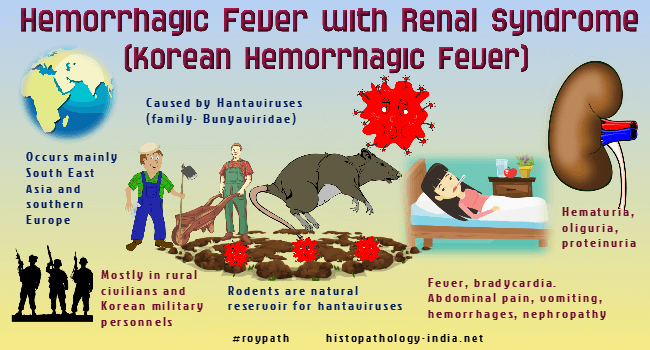|

Custom Search
|
|
Infectious Disease Online Pathology of Hemorrhagic Fever with Renal Syndrome (Korean Hemorrhagic Fever) caused by Hantavirus
|

|
Hemorrhagic fever with renal syndrome
includes diseases such as Korean hemorrhagic fever, epidemic
hemorrhagic fever, and nephropathia epidemica.
It is a group of clinically similar illnesses caused by hantaviruses from the family Bunyaviridae. In Europe, hemorrhagic fever with renal failure syndrome is caused by 3 hantaviruses: Puumala virus (PUUV), carried by the bank vole (Myodes glareolus); Dobrava virus (DOBV), carried by the mouse (Apodemus flavicollis); and Saaremaa virus (SAAV), carried by the striped field mouse (Apodemus agrarius). Hantavirus is usually acquired directly from rodents. In these rodents, the virus is detected primarily in the lung and kidney, where it is able to persist in the presence of serum antibodies. Large quantities of virus are excreted throughout life. Hemorrhagic fever with renal syndrome (Korean Hemorrhagic fever) occurs in rural communities where people may become infected through minor cuts and abrasions contaminated with rodent urine or feces, but evidence also suggests that aerosol infection may occur where virus contamination is heavy. The illness was known to Russians in Vladivostok (1890), and similar diseases are found across the entire European land mass, from European and Asiatic Russia to Manchuria, Korea, and Japan. The disease became known to American medicine when it struck United Nations troops serving in Korea in 1951, hence the misnomer "Korean".
Principal laboratory findings are proteinuria, hemoconcentration, and thrombocytopenia. Recovery is usual, but fatal cases do occur. In such cases, morphologic evidence of shock is present. There is a mononuclear cell infiltrate in the sinusoids of liver and spleen, and throughout the body damage to the capillaries is manifested by dilatation, engorgement, diapedesis of erythrocytes, and rupture. Viral antigen has been found in endothelial cells. Patients are determined to have HFRS if they have serologic test results positive for hantavirus infection or evidence of hantavirus antigen in tissue by immunohistochemical staining and microscope examination.
|
Further reading:Isolation of the etiologic agent of Korean Hemorrhagic fever.Korean hemorrhagic fever among rural residents in JapanHemorrhagic fever with renal syndrome (HFRS, Korean hemorrhagic fever).Pediatr Nephrol. 2007 Jan;22(1):156-7. Epub 2006 Sep 16. International Notes on Korean Hemorrhagic Fever.MMWR. February 19, 1988 / 37(6);87-90,95-6 Hemorrhagic fever with the renal syndrome: modern aspects of epidemiology and prophylaxis. |
|
|
Visit:- Dermatopathology Online

|
Copyright © 2022 histopathology-india.net